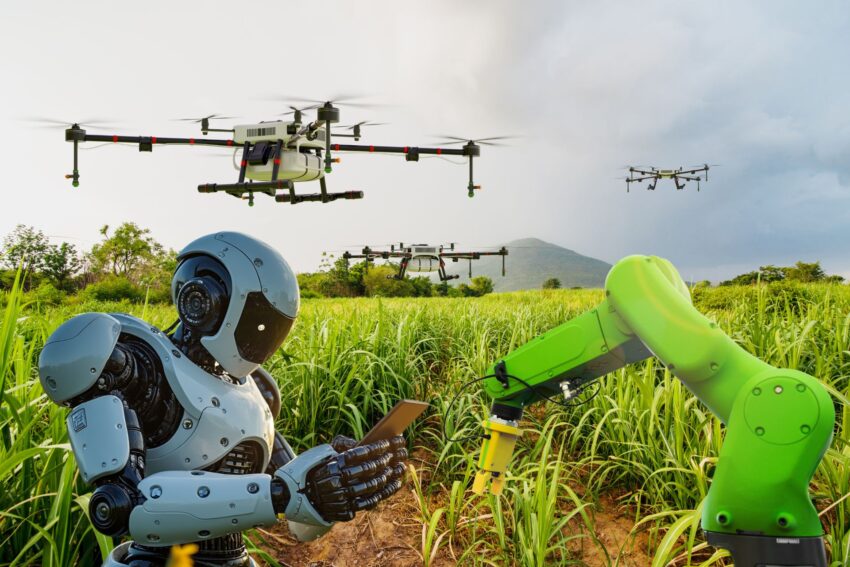In an era where technology promises to revolutionize every aspect of life, agriculture stands at a crossroads. The future of farming, as envisioned by many, might soon see fields devoid of human hands, replaced by the whir of drones, the precision of robotics, and the omnipresent eye of AI. This transformation, while heralded for its efficiency and productivity, raises profound questions about the role of farmers, the essence of agrarian life, and the control over our food supply.
The Rise of Corporate Agriculture
Recent trends suggest a dramatic shift towards corporate land ownership. There is growing concern about the disappearance of small farms. For instance, statistics from the USDA indicate a significant reduction in the number of farms, pointing towards consolidation into larger, corporate entities. Zero Hedge recently pointed out, “In the US, small farms accounted for less than 25% of food production in 2020, down from nearly half in the 1990s.”
This shift is not just about scale but also about control. Giant corporations, with their deep pockets, are increasingly investing in “climate-smart” GMOs, promising higher yields with less environmental impact. However, this approach often sidelines traditional farming methods, which, while less technologically intensive, are deeply rooted in sustainable practices and local ecosystems.
Automation Over Agrarianism
Robots are increasingly performing tasks that were once labor-intensive or required human precision. This includes planting, weeding, harvesting, and even monitoring crop health. For instance, robots like those from Agrobot can harvest strawberries, while others use lasers or mechanical means to eliminate weeds without the need for herbicides. By automating repetitive tasks, robots can work around the clock, increasing the speed and efficiency of farming operations. They can handle tasks in conditions where human labor might be less effective, like during extreme weather or at night. This is especially appealing in developed countries, where agriculture has been facing labor shortages.
🚜🌾 Breaking: AI is revolutionizing farming!
From predicting yields to optimizing resources, this tech is driving the future of agriculture.🤖🌍https://t.co/GZ2Lnsx4VF#agriculture #farming #InnovationNews— PopAi (@popaiinone) August 28, 2024
However, the integration of AI, robotics, and drones into agriculture isn’t just about reducing labor costs; it’s about redefining what farming looks like. These technologies, while capable of incredible precision in planting, monitoring, and harvesting, remove the human element from farming. This shift could lead to what some might call the ‘dehumanization’ of agriculture, where the connection between people and the land they cultivate is severed. Agrarian societies, historically, have shown that people are happier and more connected when they engage directly with nature, understanding the rhythms of the seasons and the life cycles of crops and animals.
The Value of Small Farms
Small farms, often overlooked in discussions about global food security, play a crucial role. They are not just about producing food but about resilience, independence, and community. These farms often prioritize local markets, reducing the carbon footprint associated with food transport and fostering local economies. Moreover, small farms are typically more biodiverse, which is essential for ecological health. The sentiment on platforms like X reflects a growing awareness of this value, with users advocating for the preservation of small-scale agriculture as a bastion of food sovereignty.
America's Farmers are getting wiped out.
Leaving hollowed-out communities that rival the rust-belt.
According to the USDA, we’ve lost 140,000 farms just in the last 5 years.
What’s driving it is inflationary costs, falling revenue, and green mandates.
One new rule alone, on… pic.twitter.com/OXkzAf43FC
— Peter St Onge, Ph.D. (@profstonge) March 15, 2024
Food Sovereignty and Resilience
The essence of having control over one’s food supply cannot be overstated. This control, often termed food sovereignty, is about communities having the right to define their own food systems, which are ecologically, socially, economically, and culturally appropriate. When farming becomes a corporate endeavor, this sovereignty is at risk. The removal of farmers from the equation could lead to a scenario where food production is dictated by profit margins rather than nutritional needs or the impact on the local community.
The Human Cost
The move towards farming without farmers isn’t just an economic or technological shift; it’s a cultural one. Farming, as one of the oldest professions, has been central to human civilization, embedding values of stewardship, community, and connection to the land. The loss of this connection could lead to a broader societal disconnect from where our food comes from, impacting everything from health to environmental awareness.
Couple in their 30’s farm less than 500 acres.
Wife is part owner of a local restaurant.
Restaurant is the main buyer of their meat, eggs, & produce.
→ 99% of their crops are either livestock feed or sold direct to consumer.
Husband has been on-farm full time for 3 years;…
— Clint Fischer (@clintwfischer) July 10, 2024
Conclusion
The trend towards robotic farming is likely to continue, with advancements in AI, robotics, and IoT (Internet of Things) further integrating these technologies into every aspect of farming. This could lead to fully autonomous farms where human intervention is minimal, focusing more on oversight and strategic decision-making. There’s a mix of awe and concern regarding robots in farming. On one hand, they’re seen as marvels of technology making our lives easier; on the other, there’s worry about job losses, the human touch in farming, and the ethics of automation in agriculture.
The future of farming, if left unchecked, might indeed see a landscape where corporate giants, aided by technology, control food production. However, this vision contrasts sharply with the benefits of agrarian societies, where farming is not just about food but about life, community, and culture. The challenge lies in balancing technological advancements with the preservation of small farms and the human element in agriculture. Ensuring that food production remains in the hands of many, not just a few, might be the key to maintaining resilience, independence, and a deeper connection to the land that sustains us all.


